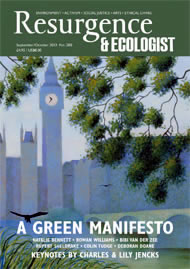George Monbiot may have a few more grey hairs these days but he’s lost none of the boyish enthusiasm that propelled him to prominence as a firebrand campaigner and columnist. Despite the decaff and rather anonymous appearance, his phone displays dire warnings not to answer calls from those intent on verbal prize-fighting: a reminder that although unnoticed, he’s a big animal to be contained in a bookshop café in Oxford.
This habitat is a long way from the Wales he describes in Feral where, from a kayak in Cardigan Bay, the landscape draws out the Nature writer in him: “I slid down the stream and back into the estuary. As I rounded the last bend in the river, the wind buffeted me. I could see, across miles of water, all the way to the sea. Here, within the fortress of cloud that guarded the hills, the land was ochre, olive, viridian. Beyond the weather curtain, in coastal sunshine, the fields, brightened by fertilizer, seemed almost to fluoresce.”
George sees this chemically enhanced green land – deforested, nibbled to the quick by sheep, which replaced the great wild beasts so utterly that their loss is only compensated by new myths about big cats and a desire to ‘reintroduce’ the ghosts – as the spark to search for an enchantment to be found in the wild lives of wild places. This search leads him around the world to good and bad examples of environmental practice, scientific theory and ways of living with Nature gathering around a big idea that “foresees large areas of self-willed land and sea, repopulated by the beasts now missing from these places, in which we may freely roam”. That idea is Rewilding.
For George, this wildness comes alive through direct experience: biting into a cockchafer grub, catching a spider crab, hoisting a dead muntjac on his shoulder and making off with it, feeling the heft of a Bronze Age aurochs vertebra in his hand. These are confirmations. They matter in ways he observed in the Yanomami in Roraima and the Maasai of Serengeti. They mattered to Mesolithic nomads, in whose footsteps he hunts eels in the Welsh estuary. But that visceral, thrilling connection with wild Nature is vanishing across the world. Rewilding – returning species to the places they once inhabited – George is convinced, is the idea that will turn Rachel Carson’s apocalyptic vision of the silent spring into a life-affirming “raucous summer”.
Candidates for reintroduction to rewilding projects in Britain are indeed a raucous lot. Here are a few mammals that once roamed these shores until they were pushed into extinction, and it is these that are now under consideration: beaver, wild boar, elk (moose), reindeer, wild horse, bison, saiga antelope, lynx, wolf, bear, wolverine, lion, spotted hyena, elephant, black rhinoceros, hippopotamus, grey whale, walrus. But if it took a generation to reintroduce a few beavers to Scotland, what chance is there for wolves, let alone elephants? Elephants!
“There have been no papers on reintroducing elephants,” says George mischievously. “This is the first discussion of rewilding with elephants.” A big idea needs a big symbolic focus, and they don’t get much bigger. George has been inspired by the ecological theory of trophic cascades, where the presence of big beasts such as elephant or lion has such a profound effect that it cascades down through all the ecological relationships to change the ecosystem, rather than previous theories that insisted an ecosystem had to be managed from the bottom up to support the big beast.
“It doesn’t have to be elephants,” he says. “We can’t universalise preferences, but the return of self-willed large beasts may encourage places to become what they were once like. Trophic cascades is one of the most exciting discoveries, leading to a re-exploration, a rediscovery of a thrilling ecology.” George thinks ecology has become a poorly informed science, trying to extrapolate a picture of ecosystem function from the remains of 6,000 years of environmental degradation. “The loss of big animals means you can’t extrapolate; without them ecosystems are not functioning at all.”
Although there is excitement in some quarters, the resistance to rewilding is also elephantine. Landowners benefiting from the “feudal taxes of farm subsidies”, which they fear they’ll lose through rewilding; conservation groups fixated on wild flowers and butterflies of traditional farmland, which they fear they’ll lose through rewilding; and a political technocracy, a monoculture of middle managers dominated by business, obsessed with endless growth and completely lacking in vision, that has “killed the possibility of a polyculture of the natural world and politics”.
George is very conscious of two of the major problems with rewilding. The first is an assumption that rewilding could mean we don’t have to fight to conserve wildlife populations and species any more – a kind of biodiversity-offsetting. And secondly, it could be used to justify scorched-earth policies on areas outside rewilding that become factory floor environments. This, he feels, should be addressed through more rewilding projects in farming rather than separating them out.
There’s another kind of elephant to consider. Although they find it hard to admit publicly, many conservationists are well aware that traditional conservation has failed. This failure is the elephant in the room, an unavoidable yet barely communicable truth. George sees rewilding and the return of lost animals as the kind of vision people can rally around.
However, pressed on communicating value in his arguments supporting rewilding, George paddles his canoe back to those moments in the estuary in which he reflects on the five-year project of discovery, a vision of trees returning to bare hills and the return of creatures to enchant his children and grandchildren. “It’s about the wonder, delight, enchantment,” he says. “This is a more effective means of persuasion. We can dress it up in the language of science later, but paradoxically it’s easier to use preferences to reach people.”
Then, as if in confirmation, a wild dolphin follows his boat.







